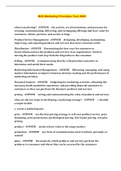Resume
Samenvatting Kernbegrippen Financial Accounting Theory
- Cours
- Établissement
- Book
Dit is een document met alle belangrijke begrippen van Financial Accounting Theory. Ideaal om snel de belangrijke begrippen te leren zonder het gehele boek te moeten doorbladeren.
[Montrer plus]













